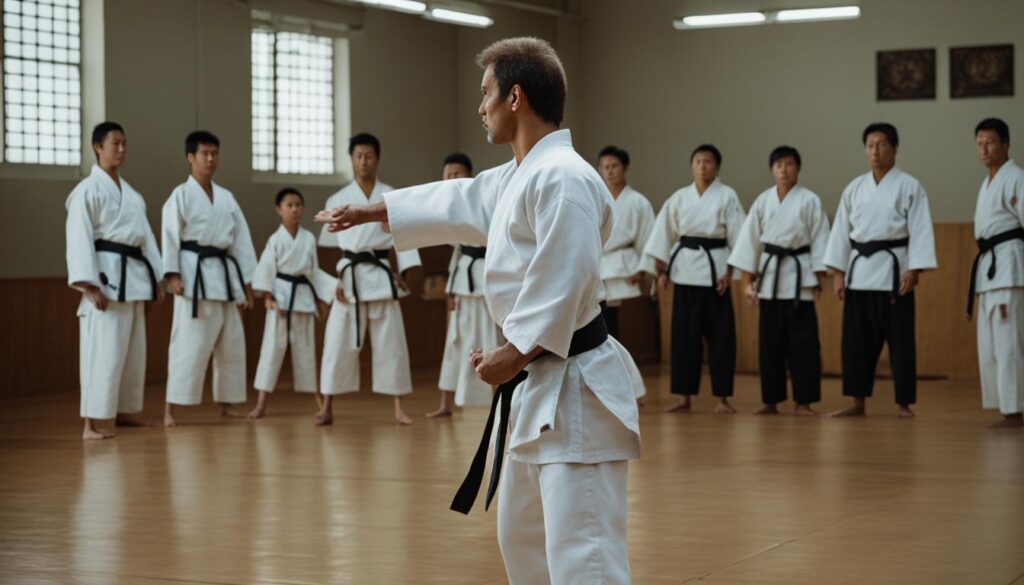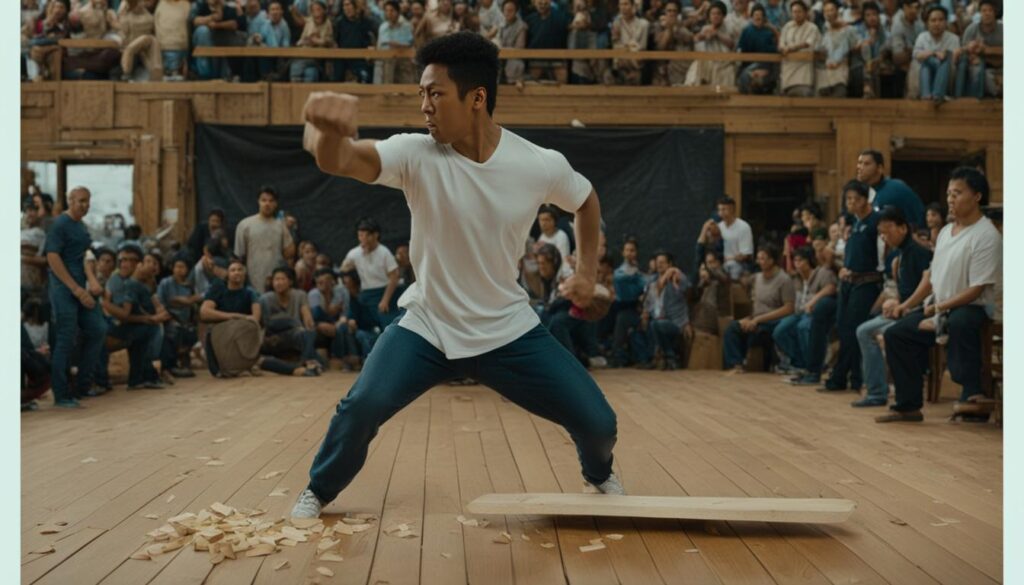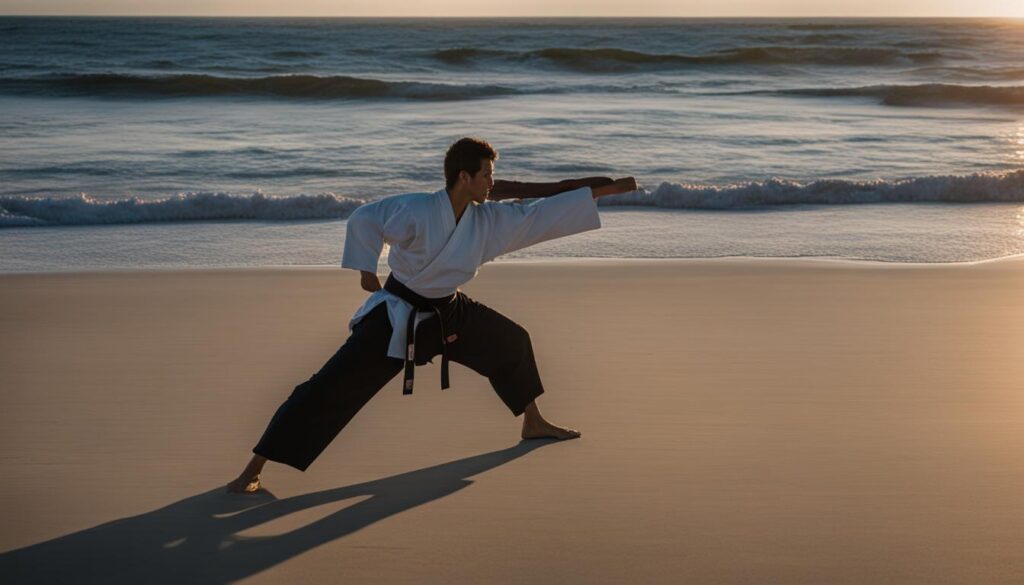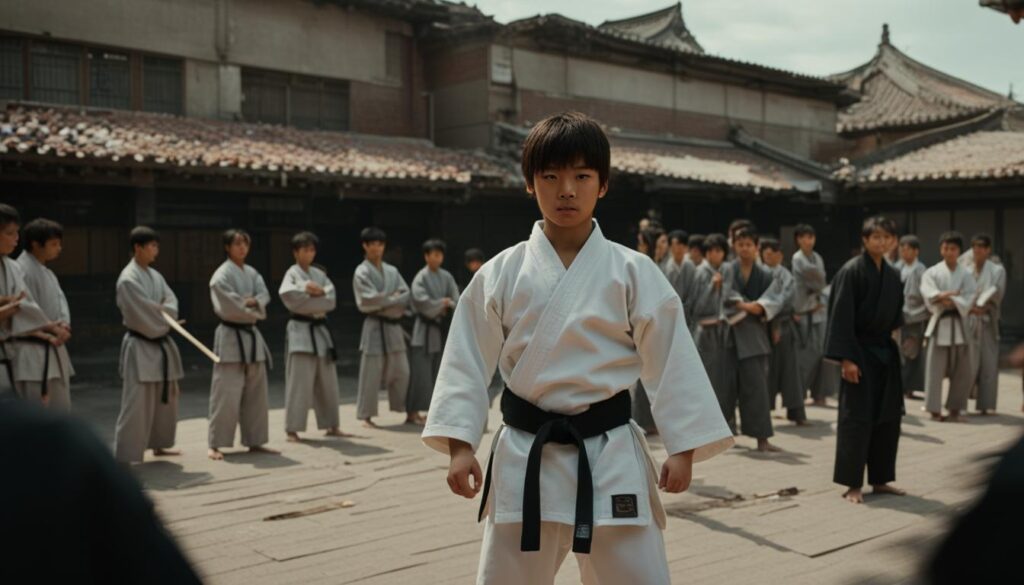Welcome to our latest article, where we debunk the common misconception that karate is simply a martial art. Many people use the terms “karate” and “martial art” interchangeably, but the reality is that karate is much more than that. Let’s explore why it is inaccurate to label karate solely as a martial art and discuss the unique elements that set it apart from traditional perceptions of martial arts.
Key Takeaways:
- Karate is often misunderstood as just a martial art, but it encompasses more than that.
- The historical origins of karate help explain its evolution from self-defense to a recreational activity.
- Karate has a distinct philosophical foundation that emphasizes character development.
- The misconception of the “no first attack” principle in karate reflects its historical context.
- Karate is a practical self-defense system rooted in real-life combat applications.
The Historical Origins of Karate
Traditional karate has its roots in Okinawa, Japan, where it was originally developed as a form of self-defense. This ancient martial art, known as Karate-Jutsu, emerged during a time of political unrest and strict weapon bans in Okinawa. Without access to traditional weapons, the people of Okinawa developed a system of unarmed combat to protect themselves.
Over time, karate techniques were refined and passed down through generations, encompassing influences from Chinese martial arts and local Okinawan fighting styles. It wasn’t until the early 20th century that karate began to spread to mainland Japan.
The transition from Okinawan Karate-Jutsu to Japanese Karate-Do marked a significant shift in the purpose and perception of karate. Karate-Do, meaning “the way of karate,” emphasized the development of mental and physical discipline, character, and personal growth. This shift from self-defense-focused martial art to a more recreational and philosophical pursuit contributed to the misconception that karate is purely a martial art.
Understanding the historical origins of karate is crucial in debunking the misconception that it is solely a martial art. By delving into its roots in Okinawa and the evolution to Karate-Do, we gain a deeper appreciation for the holistic nature of karate.
| Traditional Karate | Modern Martial Arts |
|---|---|
| Developed in Okinawa, Japan | Evolved globally |
| Emphasizes self-defense | Focuses on sport and competition |
| Incorporates different fighting styles | Adopts standardized techniques |
| Integrates physical and mental development | Often prioritizes physical prowess |
Understanding the historical origins of karate provides valuable insights into the ethos and unique characteristics that distinguish traditional karate from modern martial arts. It sheds light on the importance of holistic training, self-discipline, and the philosophical nature of karate. By recognizing these distinctions, we can appreciate karate as not just a martial art, but as a comprehensive path of personal growth and self-discovery.
The Philosophical Distinction of Karate
Unlike traditional martial arts, karate is not merely a physical combat practice. It encompasses a unique philosophical foundation that sets it apart from common misconceptions associated with martial arts.
While many martial arts lack an intrinsic moral code, karate places significant emphasis on the development of character, self-control, and mindfulness. It goes beyond the realm of physical techniques and integrates mental and physical training, creating a holistic discipline that promotes personal growth and self-improvement.
“The ultimate aim of karate lies in developing a discipline and spirit that transcend physical combat. It is the cultivation of a harmonious unity of mind and body that leads to the realization of one’s true potential.” – Gichin Funakoshi
Contrary to the misconception that karate is solely focused on aggressive combat techniques, it is, in fact, a discipline that nurtures discipline, respect, and self-awareness. The practice of karate encourages practitioners to develop patience, self-discipline, and gratitude, instilling values that extend far beyond the dojo.
The unique combination of physical techniques and philosophical principles distinguishes karate as more than just a martial art. It is a way of life that fosters personal growth, inner strength, and the pursuit of harmony between mind, body, and spirit.
Through the diligent practice of karate, individuals can tap into their inner potential and cultivate a deep sense of discipline and self-mastery. The philosophical distinction of karate challenges misconceptions and transforms it into a way of life that transcends physical combat, making it a truly transformative discipline.
The Misconception of the “No First Attack” Principle
One of the misconceptions surrounding karate is the belief in the “no first attack” principle. This principle, often associated with karate, is actually a modern invention and not a traditional moral code of Okinawan combat arts. In its historical context, karate was used to instill a ferocious warrior spirit during prewar Japan’s militaristic period. Understanding the true meaning of this principle and its evolution is essential in dispelling misconceptions about karate and physical strength.
Contrary to popular belief, karate’s unique techniques were not solely developed for defense or a reactive approach. Instead, they encompass a wide range of offensive moves designed to incapacitate opponents efficiently. This comprehensive combat system demonstrates that karate is not limited to a passive defensive art but rather a dynamic martial discipline.

Despite the false notion of karate being purely defensive, its practitioners possess a deep understanding of offensive tactics. These techniques, grounded in years of practice and refinement, empower karateka to execute powerful strikes and counterattacks with precision and agility.
- Traditional karate forms, or kata, often incorporate offensive techniques, such as punches, kicks, and elbow strikes.
- The principle of “no first attack” fails to acknowledge the effectiveness and practicality of preemptive strikes, which can neutralize threats before they escalate.
- In self-defense scenarios, knowledge and application of techniques like pressure point strikes, joint manipulations, and throws are essential for neutralizing dangers swiftly and decisively.
Dispelling the misconception regarding the “no first attack” principle helps shed light on karate’s efficiency as a martial art and challenges the misconception that it is solely a defensive discipline. Understanding karate’s true nature empowers practitioners to develop both offensive and defensive skills, contributing to a well-rounded and effective self-defense system.
The Practicality of Karate for Self-Defense
While karate has evolved into a more recreational practice, it should not be disregarded as a practical self-defense system. Karate, particularly the traditional Okinawan Karate-Jutsu, is rooted in real-life combat applications and was developed as a lethal martial art for self-defense. It equips practitioners with techniques and strategies to respond to life-threatening situations effectively. Recognizing the practicality of karate helps dispel the misconception that it is solely an art form disconnected from real-world self-defense scenarios.
Breaking Misconceptions about Strength and Flexibility in Karate
One of the most common misconceptions about karate is the belief that practitioners must possess inherent strength and exceptional flexibility to excel in the art. However, this notion couldn’t be further from the truth. Karate is a discipline that welcomes individuals of all ages, fitness levels, and body types, making it accessible and inclusive.
While strength and flexibility can certainly enhance one’s karate practice, they are not prerequisites for starting or excelling in the martial art. Karate places equal focus on developing effective techniques, discipline, mental fortitude, and strategic thinking, rather than relying solely on physical attributes.
Karate training incorporates various exercises that gradually improve strength and flexibility over time. Through consistent practice, practitioners naturally develop core strength, agility, and range of motion, irrespective of their starting point. It’s important to remember that karate is a journey of personal growth and development, wherein progress is measured by perseverance, dedication, and the mastery of techniques.
| Strengths of Karate | Misconceptions Corrected |
|---|---|
| Karate focuses on technique mastery | Karate is not solely dependent on physical strength |
| Discipline and mental fortitude are key | Fitness level and flexibility are not barriers |
| Accessible to individuals of all ages | Karate is not limited to the young and physically fit |
To embrace the true nature of karate, it is essential to challenge the misconception that strength and flexibility are the sole determining factors for success. By promoting inclusivity and recognizing that karate is a holistic practice involving both mind and body, we can expand our understanding and appreciation for this ancient martial art.
Dispelling the Theatrical Image of Karate
Many people have a theatrical perception of karate, influenced by popular media depictions that showcase acrobatic movements and flashy techniques. However, karate is not about parkour-like stunts or extravagant demonstrations. It is an ancient art that emphasizes the pursuit of perfection in forms, mental focus, and the integration of physical and psychological balance.
Unlike the theatrical portrayal of karate, which often features exaggerated techniques for entertainment purposes, traditional karate’s unique techniques focus on practicality and effectiveness in real-world self-defense scenarios. These techniques prioritize efficiency and leverage a practitioner’s body mechanics to deliver powerful strikes and swift movements.
Karate’s emphasis on discipline instills mental and physical fortitude, developing practitioners who are resilient, focused, and self-aware. The training methodologies center around consistency, repetition, and attention to detail, creating an environment conducive to personal growth and self-improvement.
“Karate is not just about kicks and punches; it’s about the development of character, self-control, and mindfulness.”
By dispelling the theatrical image associated with karate, individuals can better appreciate its essence as a disciplined practice that encompasses physical, mental, and spiritual development. Aligning our understanding of karate with its true nature allows us to fully grasp the depth and significance of this ancient martial art.

| Myth | Reality |
|---|---|
| Karate is all about flashy techniques and acrobatics. | Karate focuses on practical self-defense and the integration of mind, body, and spirit. |
| Karate performances are purely for entertainment. | Karate forms and movements are practiced for internalization and personal growth. |
| Physical strength and flexibility are essential for practicing karate. | Karate is accessible to individuals of all ages, fitness levels, and body types. |
Age is No Barrier in Karate
One of the misconceptions about karate is that it is a pursuit reserved only for the young and physically fit. This misconception arises from the belief that karate requires aggression, strength, and speed. However, karate is a discipline that goes beyond age and physical ability. It is a practice that can be embraced by individuals of all ages and backgrounds, allowing them to benefit from its holistic approach to physical and mental development.
Karate offers a unique opportunity for people to engage in a martial art that promotes discipline, self-control, and personal growth. It is not solely about physical combat; it is a way of life that molds individuals into better versions of themselves. Through regular practice, practitioners develop focus, confidence, and resilience, regardless of their age or physical attributes.
Reminding individuals that age is not a barrier in karate challenges the common misconception that it is limited to a specific demographic. Whether you are young or old, karate offers an inclusive environment where everyone can strive for personal improvement and learn valuable self-defense techniques.
Karate: More Than Kicks and Punches
Karate is often mistakenly reduced to a series of kicks and punches. However, this oversimplification fails to capture the true essence of karate as a comprehensive martial art. Karate encompasses a range of techniques, including strikes, blocks, grabs, throws, and self-defense movements. It is a full-body effort that engages both physical and mental faculties. Recognizing the multifaceted nature of karate helps clear misconceptions and reveals its depth as a martial discipline.

Karate is not just about unleashing powerful kicks and punches; it involves mastery of various techniques that go beyond mere physicality. Striking techniques, such as punches and kicks, form an integral part of karate, but they are not the sole focus. Karate also includes effective blocking techniques that allow practitioners to defend themselves against incoming attacks.
Furthermore, karate incorporates grappling techniques, where practitioners learn to control an opponent through grabs and throws. These techniques are essential for self-defense situations where physical contact is unavoidable. Mastering these grappling techniques enhances a practitioner’s overall martial arts skill set and makes karate a well-rounded martial discipline.
In addition to strikes, blocks, grabs, and throws, karate also emphasizes self-defense movements designed to neutralize attacks from various angles and positions. These movements involve redirecting an opponent’s energy and leveraging their momentum against them. By incorporating these self-defense movements, karate equips practitioners with practical skills that can be applied in real-life situations.
Furthermore, karate training goes beyond the physical aspects and encompasses mental discipline as well. Practitioners learn to cultivate focus, adaptability, patience, and discipline. Mental fortitude is essential in mastering karate techniques and applying them effectively under pressure. This mental aspect distinguishes karate from other martial arts and highlights its holistic approach to self-development.
Expanding the Perception of Karate
By recognizing the complexity and breadth of karate techniques, we can challenge and dispel common misconceptions about the art. Karate goes beyond mere kicks and punches, offering a comprehensive range of techniques that engage both the body and mind.
Karate is not limited to a few basic techniques. It is a dynamic and multifaceted martial art that involves strikes, blocks, grabs, throws, self-defense movements, and mental discipline. Understanding these aspects of karate helps us appreciate its true depth and dispel misconceptions about its limited range of techniques.
Debunking Misconceptions about Dangerous Training
One of the biggest misconceptions surrounding karate is the belief that it is a dangerous and violent sport. This misconception often stems from concerns about injuries during sparring or the perception of constant combat. However, karate training involves much more than full-contact sparring.
Most training is done individually, focusing on form practice and controlled techniques. Safety measures, including protective gear, are implemented during sparring sessions to minimize the risk of injuries. It is important to debunk the misconception of dangerous training in karate to address concerns and foster a better understanding of the art.
Karate training encompasses various aspects, including kihon (fundamental techniques), kata (forms), and kumite (sparring). While sparring may involve controlled contact, it is not the sole focus of training. In fact, the majority of training is dedicated to perfecting technique, developing physical fitness, and cultivating mental discipline.
By emphasizing discipline and respect, karate instills a sense of responsibility in practitioners, ensuring that training is conducted in a safe and controlled environment. Instructors are trained to guide students through their karate journey, prioritizing safety and injury prevention.
Karate’s goal is not to promote violence or harm, but rather to cultivate self-defense skills, self-confidence, and character development. It is a holistic practice that encompasses physical, mental, and spiritual growth.
The image below highlights the focus on controlled techniques and safety in karate training:

As depicted in the image, karate practitioners are engaged in a controlled sparring session, wearing protective gear to minimize the risk of injuries. This demonstrates the emphasis on safety and responsible training in karate.
Dispelling the misconception of dangerous training in karate is crucial in fostering a better understanding of the art and encouraging more individuals to explore its benefits. Karate is not about promoting violence; it is a disciplined practice that aims to develop physical strength, mental fortitude, and personal growth.
The Journey Beyond the Black Belt
Many people view earning a black belt as the pinnacle of achievement in karate. However, this misconception fails to recognize that the black belt signifies the beginning of a practitioner’s journey rather than the end. The black belt represents the mastery of the basics and opens the door to further exploration and advancement in karate. Understanding that the black belt is not the ultimate destination challenges the misconception that it symbolizes mastery and dispels the notion that mastery is solely defined by physical strength.
As a practitioner progresses beyond the black belt, they delve deeper into the intricacies of karate’s unique techniques. They explore advanced forms, kata, and applications that require refined skill and understanding. This continued journey in karate is not merely about physical prowess but encompasses the development of mental focus, discipline, and the integration of body and mind.
Contrary to popular misconceptions, the journey beyond the black belt is not solely focused on physical strength. While physical fitness is important in karate, mastery extends beyond the realm of physical prowess. It encompasses the honing of one’s technique, mental fortitude, self-control, and the application of karate principles in daily life.
During this ongoing journey, practitioners continue to refine their techniques and expand their knowledge. They explore the deeper philosophical aspects of karate, embracing its values of respect, humility, and perseverance. The journey beyond the black belt invites practitioners to evolve holistically, both as martial artists and as individuals.
By dispelling the misconception that the black belt is the ultimate goal, we recognize that karate is a lifelong pursuit of self-improvement. It is a continuous journey that encompasses physical, mental, and spiritual growth. Embracing this understanding allows practitioners to appreciate the depth and richness of karate beyond the confines of preconceived notions and misconceptions.
Conclusion
Karate is often misunderstood and limited to being perceived solely as a martial art. However, by debunking the misconceptions surrounding karate, a deeper understanding of its true essence can be achieved. It is important to address the misconception that karate is inherently violent, as it is a discipline that emphasizes self-control, character development, and mindfulness.
Another common misconception is that karate relies heavily on physical strength. While strength can be beneficial, karate is accessible to individuals of all fitness levels and body types. It is a discipline that focuses on technique, discipline, and mental fortitude, rather than solely relying on physical attributes.
Furthermore, karate is not merely about kicks and punches. It encompasses a wide range of techniques, including strikes, blocks, grabs, throws, and self-defense movements. This multifaceted nature of karate demonstrates its depth as a martial discipline.
Overall, dispelling misconceptions about karate and embracing its unique elements leads to a more comprehensive appreciation of its true nature. Karate is not just a martial art; it is a discipline that encompasses physical and mental development, fostering self-control, character growth, and a well-rounded approach to self-defense.
FAQ
Why is it inaccurate to call karate a martial art?
Karate should not be limited to being called just a martial art because it has a distinct philosophical foundation and combines mental and physical training.
What are the differences between karate and martial arts?
While karate is a form of martial art, it sets itself apart with its unique elements, including its historical origins and emphasis on character development and self-control.
What are some misconceptions about karate?
Some common misconceptions about karate include the belief that it requires physical strength, that it is solely about kicks and punches, and that it is a dangerous and violent sport.
What are the historical origins of karate?
Karate originated in Okinawa, Japan, as a form of self-defense and later spread to mainland Japan. It evolved from a self-defense-focused practice to a more sports-oriented activity.
What is the philosophical distinction of karate?
Unlike many other martial arts, karate emphasizes the development of character, self-control, and mindfulness. It is a discipline that combines mental and physical training.
What is the “no first attack” principle in karate?
The “no first attack” principle associated with karate is a modern invention and not a traditional moral code of Okinawan combat arts. It was developed during prewar Japan’s militaristic period to instill a ferocious warrior spirit.
Is karate practical for self-defense?
Yes, karate, especially the traditional Okinawan Karate-Jutsu, is rooted in real-life combat applications and was developed for effective self-defense. It equips practitioners with techniques and strategies to respond to life-threatening situations.
Do you have to be physically strong and flexible to practice karate?
No, karate is accessible to individuals of all ages, fitness levels, and body types. While strength and flexibility can enhance one’s practice, they are not prerequisites for learning karate.
Is karate mostly about parkour-like stunts and flashy techniques?
No, karate is an ancient art that emphasizes the pursuit of perfection in forms, mental focus, and the integration of physical and psychological balance. It is not about theatrical demonstrations but disciplined practice.
Is karate only for the young and physically fit?
No, karate is a discipline that transcends age and physical ability. Practitioners of all ages and backgrounds can engage in karate and benefit from its holistic approach to physical and mental development.
Is karate just about kicks and punches?
No, karate encompasses a range of techniques, including strikes, blocks, grabs, throws, and self-defense movements. It is a comprehensive martial art that engages both physical and mental faculties.
Is karate a dangerous and violent sport?
No, while some concerns may arise from sparring sessions, most karate training is focused on form practice and controlled techniques. Safety measures, including protective gear, are implemented during sparring sessions to minimize the risk of injuries.
What does earning a black belt in karate signify?
Earning a black belt in karate represents the mastery of the basics and the beginning of a practitioner’s journey. It signifies the opening of doors to further exploration and advancement in karate, rather than being the ultimate destination of mastery.
